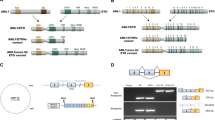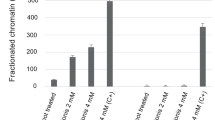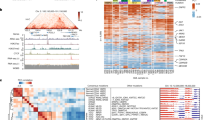Abstract
The chromosomal translocation (8;21) fuses the hematopoietic transcription factor AML1 (RUNX1) with ETO (RUNX1T1, MTG8), resulting in the leukemia-specific chimeric protein AML1/ETO. This fusion protein has been implicated in epigenetic silencing, recruiting histone deacetylases (HDACs) and DNA methyltransferases to target promoters. Previously, we have identified a novel in vivo AML1/ETO target gene, LAT2 (NTAL/LAB/WBSCR5), which is involved in FcɛR I, c-Kit, B-cell and T-cell receptor signalling. We have now addressed the molecular mechanisms of AML1/ETO-mediated LAT2 repression. In Kasumi-1 cells, where AML1/ETO bound to the LAT2 gene, small interfering RNA (siRNA)-mediated AML1/ETO depletion caused upregulation of LAT2, suggesting a possible direct mechanism of repression. Expression of AML1/ETO was associated with a decrease in acetylation of histones H3, H3K9 and H4, and an increase in H3K9 and H3K27 trimethylation. The class I-specific HDAC inhibitors entinostat (MS-275) and mocetinostat (MGCD0103) induced LAT2 expression specifically in AML1/ETO-expressing cells, resulting in induction of several activating histone marks on the LAT2 gene, including trimethylation of histone H3K4. The combination of entinostat and decitabine increased acetylation of histones H3 and H4, as well as LAT2 mRNA expression, in an at least additive fashion. In conclusion, several repressive histone modifications mark the LAT2 gene in the presence of AML1/ETO, and LAT2 gene derepression is achieved by pharmacological inhibition of HDACs.
This is a preview of subscription content, access via your institution
Access options
Subscribe to this journal
Receive 50 print issues and online access
$259.00 per year
only $5.18 per issue
Buy this article
- Purchase on SpringerLink
- Instant access to full article PDF
Prices may be subject to local taxes which are calculated during checkout







Similar content being viewed by others
References
Alcalay M, Meani N, Gelmetti V, Fantozzi A, Fagioli M, Orleth A et al. (2003). Acute myeloid leukemia fusion proteins deregulate genes involved in stem cell maintenance and DNA repair. J Clin Invest 112: 1751–1761.
Amann JM, Nip J, Strom DK, Lutterbach B, Harada H, Lenny N et al. (2001). ETO, a target of t(8;21) in acute leukemia, makes distinct contacts with multiple histone deacetylases and binds mSin3A through its oligomerization domain. Mol Cell Biol 21: 6470–6483.
Barbetti V, Gozzini A, Rovida E, Morandi A, Spinelli E, Fossati G et al. (2008). Selective anti-leukaemic activity of low-dose histone deacetylase inhibitor ITF2357 on AML1/ETO-positive cells. Oncogene 27: 1767–1778.
Barski A, Cuddapah S, Cui K, Roh TY, Schones DE, Wang Z et al. (2007). High-resolution profiling of histone methylations in the human genome. Cell 129: 823–837.
Berg T, Fliegauf M, Burger J, Staege MS, Liu S, Martinez N et al. (2008). Transcriptional upregulation of p21/WAF/Cip1 in myeloid leukemic blasts expressing AML1-ETO. Haematologica 93: 1728–1733.
Berg T, Guo Y, Abdelkarim M, Fliegauf M, Lübbert M . (2007). Reversal of p15/INK4b hypermethylation in AML1/ETO-positive and -negative myeloid leukemia cell lines. Leuk Res 31: 497–506.
Blum W, Klisovic RB, Hackanson B, Liu Z, Liu S, Devine H et al. (2007). Clinical, pharmacokinetic, and pharmacodynamic results of a phase I study of decitabine alone or in combination with valproic acid in acute myeloid leukemia. J Clin Oncol 25: 3884–3891.
Brdicka T, Imrich M, Angelisová P, Brdicková N, Horváth O, Spicka J et al. (2002). Non-T cell activation linker (NTAL): a transmembrane adaptor protein involved in immunoreceptor signaling. J Exp Med 196: 1617–1626.
Burel SA, Harakawa N, Zhou L, Pabst T, Tenen DG, Zhang DE . (2001). Dichotomy of AML1-ETO functions: growth arrest versus block of differentiation. Mol Cell Biol 21: 5577–5590.
Cameron EE, Baylin SB, Herman JG . (1999). p15(INK4B) CpG island methylation in primary acute leukemia is heterogeneous and suggests density as a critical factor for transcriptional silencing. Blood 94: 2445–2451.
Claus R, Fliegauf M, Stock M, Duque J, Kolanczyk M, Lübbert M . (2006). Inhibitors of DNA methylation and histone deacetylation independently relieve AML1/ETO-mediated lysozyme repression. J Leukoc Biol 80: 1462–1472.
Di Croce L, Raker VA, Corsaro M, Fazi F, Fanelli M, Faretta M et al. (2002). Methyltransferase recruitment and DNA hypermethylation of target promoters by an oncogenic transcription factor. Science 295: 1079–1082.
Dunne J, Cullmann C, Ritter M, Soria NM, Drescher B, Debernardi S et al. (2006). siRNA-mediated AML1/MTG8 depletion affects differentiation and proliferation-associated gene expression in t(8;21)-positive cell lines and primary AML blasts. Oncogene 25: 6067–6078.
Duque-Afonso J, Solari L, Essig A, Berg T, Pahl HL, Lübbert M . (2011). Regulation of the adaptor molecule LAT2, an in vivo target gene of AML1/ETO, during myeloid differentiation. Br J Haematol (e-pub ahead of print 13 April 2011).
Erickson P, Gao J, Chang KS, Look T, Whisenant E, Raimondi S et al. (1992). Identification of breakpoints in t(8;21) acute myelogenous leukemia and isolation of a fusion transcript, AML1/ETO, with similarity to Drosophila segmentation gene, runt. Blood 80: 1825–1831.
Fazi F, Rosa A, Fatica A, Gelmetti V, De Marchis ML, Nervi C et al. (2005). A minicircuitry comprised of microRNA-223 and transcription factors NFI-A and C/EBPalpha regulates human granulopoiesis. Cell 123: 819–831.
Fazi F, Zardo G, Gelmetti V, Travaglini L, Ciolfi A, Di Croce L et al. (2007). Heterochromatic gene repression of the retinoic acid pathway in acute myeloid leukemia. Blood 109: 4432–4440.
Fliegauf M, Stock M, Berg T, Lübbert M . (2004). Williams-Beuren syndrome critical region-5/non-T-cell activation linker: a novel target gene of AML1/ETO. Oncogene 23: 9070–9081.
Garcia-Manero G, Kantarjian HM, Sanchez-Gonzalez B, Yang H, Rosner G, Verstovsek S et al. (2006). Phase 1/2 study of the combination of 5-aza-2’-deoxycytidine with valproic acid in patients with leukemia. Blood 108: 3271–3279.
Gelmetti V, Zhang J, Fanelli M, Minucci S, Pelicci PG, Lazar MA . (1998). Aberrant recruitment of the nuclear receptor corepressor-histone deacetylase complex by the acute myeloid leukemia fusion partner ETO. Mol Cell Biol 18: 7185–7191.
Gore SD, Baylin S, Sugar E, Carraway H, Miller CB, Carducci M et al. (2006). Combined DNA methyltransferase and histone deacetylase inhibition in the treatment of myeloid neoplasms. Cancer Res 66: 6361–6369.
Hauswald S, Duque-Afonso J, Wagner MM, Schertl FM, Lübbert M, Peschel C et al. (2009). Histone deacetylase inhibitors induce a very broad, pleiotropic anticancer drug resistance phenotype in acute myeloid leukemia cells by modulation of multiple ABC transporter genes. Clin Cancer Res 15: 3705–3715.
Heidenreich O, Krauter J, Riehle H, Hadwiger P, John M, Heil G et al. (2003). AML1/MTG8 oncogene suppression by small interfering RNAs supports myeloid differentiation of t(8;21)-positive leukemic cells. Blood 101: 3157–3163.
Hoogenkamp M, Lichtinger M, Krysinska H, Lancrin C, Clarke D, Williamson A et al. (2009). Early chromatin unfolding by RUNX1: a molecular explanation for differential requirements during specification versus maintenance of the hematopoietic gene expression program. Blood 114: 299–309.
Janssen E, Zhu M, Zhang W, Koonpaew S, Zhang W . (2003). LAB: a new membrane-associated adaptor molecule in B cell activation. Nat Immunol 4: 117–123.
Klisovic MI, Maghraby EA, Parthun MR, Guimond M, Sklenar AR, Whitman SP et al. (2003). Depsipeptide (FR 901228) promotes histone acetylation, gene transcription, apoptosis and its activity is enhanced by DNA methyltransferase inhibitors in AML1/ETO-positive leukemic cells. Leukemia 2: 350–358.
Jiemjit A, Fandy TE, Carraway H, Bailey KA, Baylin S, Herman JG et al. (2008). p21(WAF1/CIP1) induction by 5-azacytosine nucleosides requires DNA damage. Oncogene 27: 3615–3623.
Khan N, Jeffers M, Kumar S, Hackett C, Boldog F, Khramtsov N et al. (2008). Determination of the class and isoform selectivity of small-molecule histone deacetylase inhibitors. Biochem J 409: 581–589.
Krivtsov AV, Armstrong SA . (2007). MLL translocations, histone modifications and leukaemia stem-cell development. Nat Rev Cancer 7: 823–833.
Lamprecht B, Walter K, Kreher S, Kumar R, Hummel M, Lenze D et al. (2010). Derepression of an endogenous long terminal repeat activates the CSF1R proto-oncogene in human lymphoma. Nat Med 5: 571–579.
Linggi B, Müller-Tidow C, van de Locht L, Hu M, Nip J, Serve H et al. (2002). The t(8;21) fusion protein, AML1 ETO, specifically represses the transcription of the p14(ARF) tumor suppressor in acute myeloid leukemia. Nat Med 8: 743–750.
Liu S, Klisovic RB, Vukosavljevic T, Yu J, Paschka P, Huynh L et al. (2007). Targeting AML1/ETO-histone deacetylase repressor complex: a novel mechanism for valproic acid-mediated gene expression and cellular differentiation in AML1/ETO-positive acute myeloid leukemia cells. J Pharmacol Exp Ther 321: 953–960.
Liu S, Shen T, Huynh L, Klisovic MI, Rush LJ, Ford JL et al. (2005). Interplay of RUNX1/MTG8 and DNA methyltransferase 1 in acute myeloid leukemia. Cancer Res 65: 1277–1284.
Lübbert M . (2003). Gene silencing of the p15/INK4B cell-cycle inhibitor by hypermethylation: an early or later epigenetic alteration in myelodysplastic syndromes? Leukemia 17: 1762–1764.
Lutterbach B, Westendorf JJ, Linggi B, Patten A, Moniwa M, Davie JR et al. (1998). ETO, a target of t(8;21) in acute leukemia, interacts with the N-CoR and mSin3 corepressors. Mol Cell Biol 18: 7176–7184.
Maslak P, Chanel S, Camacho LH, Soignet S, Pandolfi PP, Guernah I et al. (2006). Pilot study of combination transcriptional modulation therapy with sodium phenylbutyrate and 5-azacytidine in patients with acute myeloid leukemia or myelodysplastic syndrome. Leukemia 20: 212–217.
Nightingale KP, Gendreizig S, White DA, Bradbury C, Hollfelder F, Turner BM . (2007). Cross-talk between histone modifications in response to histone deacetylase inhibitors: MLL4 links histone H3 acetylation and histone H3K4 methylation. J Biol Chem 282: 4408–4416.
Pabst T, Mueller BU, Harakawa N, Schoch C, Haferlach T, Behre G et al. (2001). AML1-ETO downregulates the granulocytic differentiation factor C/EBPalpha in t(8;21) myeloid leukemia. Nat Med 7: 444–451.
Paul TA, Bies J, Small D, Wolff L . (2010). Signatures of polycomb repression and reduced H3K4 trimethylation are associated with p15INK4b DNA methylation in AML. Blood 115: 3098–3108.
Peterson LF, Yan M, Zhang DE . (2007). The p21Waf1 pathway is involved in blocking leukemogenesis by the t(8;21) fusion protein AML1-ETO. Blood 109: 4392–4398.
Pober BR . (2010). Williams-Beuren syndrome. N Engl J Med 362: 239–252.
Richon VM, Sandhoff TW, Rifkind RA, Marks PA . (2000). Histone deacetylase inhibitor selectively induces p21WAF1 expression and gene-associated histone acetylation. Proc Natl Acad Sci USA 97: 10014–10019.
Stork B, Engelke M, Frey J, Horejsí V, Hamm-Baarke A, Schraven B et al. (2004). Grb2 and the non-T cell activation linker NTAL constitute a Ca(2+)-regulating signal circuit in B lymphocytes. Immunity 21: 681–691.
Tan J, Cang S, Ma Y, Petrillo RL, Liu D . (2010). Novel histone deacetylase inhibitors in clinical trials as anti-cancer agents. J Hematol Oncol 3: 5.
Tkaczyk C, Horejsi V, Iwaki S, Draber P, Samelson LE, Satterthwaite AB et al. (2004). NTAL phosphorylation is a pivotal link between the signaling cascades leading to human mast cell degranulation following Kit activation and Fc epsilon RI aggregation. Blood 104: 207–214.
Viale A, De Franco F, Orleth A, Cambiaghi V, Giuliani V, Bossi D et al. (2009). Cell-cycle restriction limits DNA damage and maintains self-renewal of leukaemia stem cells. Nature 457: 51–56.
Volná P, Lebduska P, Dráberová L, Símová S, Heneberg P, Boubelík M et al. (2004). Negative regulation of mast cell signaling and function by the adaptor LAB/NTAL. J Exp Med 200: 1001–1013.
Wang Y, Horvath O, Hamm-Baarke A, Richelme M, Grégoire C, Guinamard R et al. (2005). Single and combined deletions of the NTAL/LAB and LAT adaptors minimally affect B-cell development and function. Mol Cell Biol 25: 4455–4465.
Yang G, Thompson MA, Brandt SJ, Hiebert SW . (2007). Histone deacetylase inhibitors induce the degradation of the t(8;21) fusion oncoprotein. Oncogene 26: 91–101.
Zhu M, Koonpaew S, Liu Y, Shen S, Denning T, Dzhagalov I et al. (2006). Negative regulation of T cell activation and autoimmunity by the transmembrane adaptor protein LAB. Immunity 25: 757–768.
Zhu M, Liu Y, Koonpaew S, Granillo O, Zhang W . (2004). Positive and negative regulation of FcepsilonRI-mediated signaling by the adaptor protein LAB/NTAL. J Exp Med 200: 991–1000.
Acknowledgements
We would like to thank Constanze Bonifer (Leeds, UK) and Manfred Jung (Freiburg, Germany) for critically reviewing the manuscript, Eric Metzger and Roland Schüle (Freiburg) for many helpful comments during establishment of the chromatin immunoprecipitation assay, and Harald Binder (Freiburg) for statistical support. Bernhard Kleine performed the bisulfite sequencing analysis of the LAT2 promoter. We are grateful to Joost Martens and Henk Stunnenberg (Nijmegen, The Netherlands) for sharing unpublished data. J Duque-Afonso was funded by a grant from LaCaixa-DAAD (ref. 314, A/05/29785) and the fellowship program of the Department of Hematology/Oncology of the University of Freiburg. This work was supported by the German José-Carreras Foundation (R 06/40f). ML is supported by the DFG (SPP 1463, Lu 429/7-1).
Author contributions: JD performed research and wrote the paper, AY and MA performed research, TB analyzed data, OH contributed vital new reagents and revised the paper, ML designed research and wrote the paper.
Author information
Authors and Affiliations
Corresponding author
Ethics declarations
Competing interests
The authors declare no conflict of interest.
Rights and permissions
About this article
Cite this article
Duque-Afonso, J., Yalcin, A., Berg, T. et al. The HDAC class I-specific inhibitor entinostat (MS-275) effectively relieves epigenetic silencing of the LAT2 gene mediated by AML1/ETO. Oncogene 30, 3062–3072 (2011). https://doi.org/10.1038/onc.2011.32
Received:
Revised:
Accepted:
Published:
Issue date:
DOI: https://doi.org/10.1038/onc.2011.32
Keywords
This article is cited by
-
AML1/ETO and its function as a regulator of gene transcription via epigenetic mechanisms
Oncogene (2021)
-
The ubiquitin ligase RNF5 determines acute myeloid leukemia growth and susceptibility to histone deacetylase inhibitors
Nature Communications (2021)
-
Combination treatment of acute myeloid leukemia cells with DNMT and HDAC inhibitors: predominant synergistic gene downregulation associated with gene body demethylation
Leukemia (2019)
-
The pan-HDAC inhibitor panobinostat acts as a sensitizer for erlotinib activity in EGFR-mutated and -wildtype non-small cell lung cancer cells
BMC Cancer (2015)
-
Depletion of RUNX1/ETO in t(8;21) AML cells leads to genome-wide changes in chromatin structure and transcription factor binding
Leukemia (2012)



